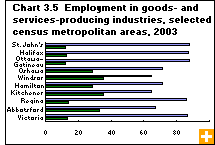Common menu bar links
Rise of the services sector in our cities
Archived Content
Information identified as archived is provided for reference, research or recordkeeping purposes. It is not subject to the Government of Canada Web Standards and has not been altered or updated since it was archived. Please contact us to request a format other than those available.
Cities offer large concentrations of people, capital, knowledge and ideas. Hence, they are seen as natural hubs for the development of service industries. The services sector typically employs more workers in cities than in rural areas and small towns. In Canada’s 27 largest cities in 2003, service jobs comprised 78% of the work force, compared with 75% in the country as a whole.
But these numbers mask some major differences among cities. Government is one of the largest providers of service sector jobs, which is why Canada’s six most services-oriented cities are also capital cities with large public-sector work forces. In these capitals, service industries employ at least 85% of the work force. By contrast, other cities in Quebec and Southern Ontario have larger-than-average shares of workers employed in goods-producing industries.
Almost all Canadian urban areas became more services-oriented during the 1990s. From 1989 to 2003, the number of jobs in the services sector grew faster than in the goods sector in all but 4 of Canada’s 27 largest urban areas. The share of workers in services grew faster in cities that had relatively low concentrations of services to start with.
The rise of service industries in our cities has coincided with a general decline in manufacturing and with an expansion of business services. Some of Canada’s strongest production centres have seen large declines. In Montréal, for instance, the manufacturing work force lost 46,300 jobs from 1989 to 2003. Business services’ fast growth has been largely the result of strong gains in professional, scientific and technical services: its share of total employment swelled from 5% in 1989 to 8% in 2003.



